
As in many regions worldwide, children in India are the most disadvantaged segment, given their overt dependence on adults for meeting all their needs. To ameliorate their condition and ensure them a better, brighter, healthier life, we at CRY (Child Rights and You) fund grassroots partners and works closely with them to deliver sustainable change for children. An indigenous Indian movement, CRY is working towards restoring basic rights – survival, protection, development and participation – to underprivileged Indian children.

The organisation was founded in Bombay in 1979 when 25 year old Rippan Kapur and six like-minded friends joined hands, backed by their core belief that every person possesses the potential and power to make a difference in the lives of children.
Independent and Effective Link
Unlike a grassroots-level organisation, we do not work directly with underprivileged children. Rather, we are the link between millions of Indians who can provide resources and thousands of dedicated people and organisations at the grassroots-level requiring resources to transform the lives of underprivileged children. This ‘link’ or enabling status has driven CRY’s strategic choices at all times – from its fund raising methods to the nature of its relationship with its NGO partners.
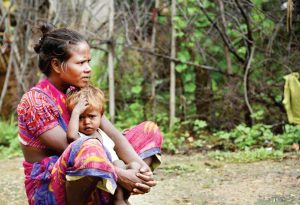 Thirty-eight years later, CRY is India’s premier child rights organisation with an established reputation for effectiveness and trust. We are now spread across 23 States in India, nurtured more than 600 grassroots organisations across the country, and through them, become a catalyst for change in the lives of nearly two million underprivileged Indian children. Identifying nascent grassroots initiatives, we nurture them through financial and non-financial support by funding ‘social entrepreneurs’.
Thirty-eight years later, CRY is India’s premier child rights organisation with an established reputation for effectiveness and trust. We are now spread across 23 States in India, nurtured more than 600 grassroots organisations across the country, and through them, become a catalyst for change in the lives of nearly two million underprivileged Indian children. Identifying nascent grassroots initiatives, we nurture them through financial and non-financial support by funding ‘social entrepreneurs’.
To ensure lasting change, we use a rights-based approach guided by the Indian Constitution, the UN Child Rights Charter and the law of the land in each country we operate. Accordingly, children’s issues are addressed in their entirety: education, health, child labour, discrimination, etc. We also examine the scope for direct interventions that will uphold children’s rights as well as by mapping and working on macro issues of the community affecting children. Communities are mobilised for collective action ensuring children’s rights are enabled, protected and nurtured, and they have a voice in matters affecting them.
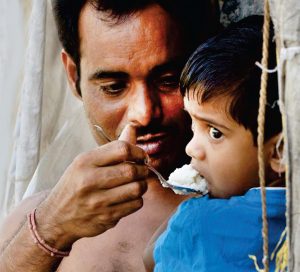 Besides, networking and strategic alliance building is used to collectively influence policy towards being child sensitive at the national, state and local levels while working in changing mindsets and attitudes towards children’s rights. Varied stakeholders with a role in bringing about lasting change are engaged: communities, NGO partners, local governance structures, society at large, privileged individuals, institutions, the corporate sector, and the Government.
Besides, networking and strategic alliance building is used to collectively influence policy towards being child sensitive at the national, state and local levels while working in changing mindsets and attitudes towards children’s rights. Varied stakeholders with a role in bringing about lasting change are engaged: communities, NGO partners, local governance structures, society at large, privileged individuals, institutions, the corporate sector, and the Government.
“Our programming approach for health and nutrition is focused on access to quality primary healthcare for all mothers and children as well as improved access to nutrition and development for children under five. This encompasses preventive and responsive aspects aimed at ensuring a significant reduction in infant and maternal mortality rates and reduction in malnourishment among children”
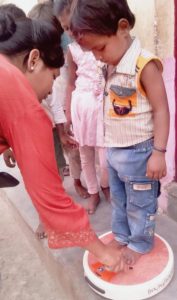 Significantly, we remain transparent, accountable and independent – without any political, corporate or donor ideology and influence – thereby permitting us to go beyond philanthropy in being a credible voice for India’s children in the realm of national policy.
Significantly, we remain transparent, accountable and independent – without any political, corporate or donor ideology and influence – thereby permitting us to go beyond philanthropy in being a credible voice for India’s children in the realm of national policy.
Our programming approach for health and nutrition is focused on access to quality primary healthcare for all mothers and children as well as improved access to nutrition and development for children under five. This encompasses preventive and responsive aspects aimed at ensuring a significant reduction in infant and maternal mortality rates and reduction in malnourishment among children.
Damoh Case Study
We also promote innovative approaches towards ensuring the consumption of diverse nutritious food in our intervention areas. Take the example of our intervention in the Damoh district of Madhya Pradesh.
Damoh comprises of seven development blocks, with Tendukheda Block being one of the most underdeveloped. The majority of tribal and Dalit households are either landless or possess so-called government forest land. The situation is one of abject poverty, landlessness, hunger, starvation and exploitation. Naturally, the nutritional status of children is very poor. Around 43 percent children aged 0-59 months are underweight and 17 percent are severely underweight. Water-borne diseases are one of the major killers.
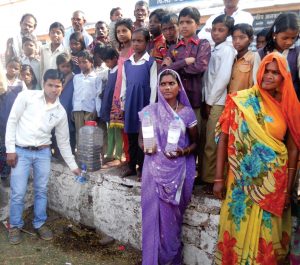 In the operational area, services are not delivered as per prescribed norms. Children are not given breakfast and only one meal is served around 1:00 PM along with the school mid-day meal, which is quite late for children in the 3-6 years age group. Moreover, food served is not as per the menu and during summer vacations, no food is provided in the ICDS (Integrated Child Development Services) centres. Thereby, children are deprived of accessing the complete benefits of ICDS programme.
In the operational area, services are not delivered as per prescribed norms. Children are not given breakfast and only one meal is served around 1:00 PM along with the school mid-day meal, which is quite late for children in the 3-6 years age group. Moreover, food served is not as per the menu and during summer vacations, no food is provided in the ICDS (Integrated Child Development Services) centres. Thereby, children are deprived of accessing the complete benefits of ICDS programme.
With CRY intervention, knowledge building on local available nutritious foods in the village was ensured, knowledgeable selection of what to eat and skilled preparation practices, including training and capacity building. Food demonstration sessions were organised. As a result of these demonstrations, families with Severe Acute Malnourished and Moderate Acute Malnourished children began practising the new cooking habits. This eventually helped in the grade movement of around 35 malnourished children in 2017 (January to May).
Other Steps Included:
· Timely referral of malnourished children to the Nutrition Rehabilitation Centre.
· Generating community awareness for lactating mothers’ access to adequate food and rest.
· Formation and strengthening of mother support groups to promote maternal and child nutrition inside villages.
· Initiation of kitchen garden facility for nutrition uptake of micro-nutrients in every household, especially in those having anaemic mothers.
· Multi-crop demo in two villages with community consensus for food productivity.
· Awareness building on water, sanitation and hygiene inside the villages for strengthening communities against social taboos and myths through community meeting and local strategy development.
Lal Kuan Case Study
We have witnessed transformational changes in communities when they are sensitised and empowered to take responsibility for their children. An interesting example of the same is witnessed in the work of our partner organisation, Matri Sudha, which has been working towards improving the health and nutritional status of children from the project intervention area of Lal Kuan, near M B Road, Delhi. Extensive programming has been done to achieve the desired goal since 2014-15.
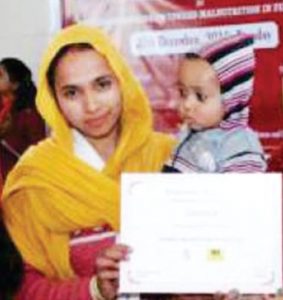 Take the case of Shakila, who lives in a joint family with her husband and three children in Lal Kuan. Upon monitoring her daughter’s growth, she was found to be malnourished. A strict patriarchal set up and a strict mother-in-law restricted her movement even when she had to take her daughter to the primary health centre. When Anganwadi workers visited her home, they pointed the extreme health complications of her daughter. With the intervention and counselling of our partner -MatriSudha, Shakila stood up against her in-laws and got her daughter admitted. Regular visits and continued treatment ensured her daughter was not undernourished anymore. Shakila now attends monthly meetings on nutrition with other community members and Aanganwadi workers, encourages other mothers in the community to ensure regular growth monitoring of children, encourages good feeding and nutrition practices, and has become a role model for defying societal norms to take responsibility for children.
Take the case of Shakila, who lives in a joint family with her husband and three children in Lal Kuan. Upon monitoring her daughter’s growth, she was found to be malnourished. A strict patriarchal set up and a strict mother-in-law restricted her movement even when she had to take her daughter to the primary health centre. When Anganwadi workers visited her home, they pointed the extreme health complications of her daughter. With the intervention and counselling of our partner -MatriSudha, Shakila stood up against her in-laws and got her daughter admitted. Regular visits and continued treatment ensured her daughter was not undernourished anymore. Shakila now attends monthly meetings on nutrition with other community members and Aanganwadi workers, encourages other mothers in the community to ensure regular growth monitoring of children, encourages good feeding and nutrition practices, and has become a role model for defying societal norms to take responsibility for children.
Since 2015, the project has been working extensively towards mitigating urban malnutrition working with the ICDS Department. A study was conducted in the project intervention area. The findings revealed only 25 percent pregnant women knew that a child should be exclusively breastfed until six months, and 40 percent respondents still preferred visiting unqualified doctors in case of illness during pregnancy rather than the public health centre. Accordingly, in 2016, the project worked towards the issue of postnatal care, IYCF (Infant and Young Child Feeding) and community behaviour change on health-seeking behaviour.
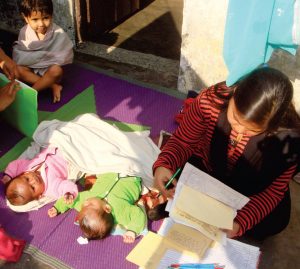 Due to extensive work on malnutrition, the project reported a change in the overall status of malnutrition from 69 percent children in normal grade in January 2016 to 75 percent by June 2016. The percentage of severely underweight children also fell from 11 percent to 6.6 percent during this period.
Due to extensive work on malnutrition, the project reported a change in the overall status of malnutrition from 69 percent children in normal grade in January 2016 to 75 percent by June 2016. The percentage of severely underweight children also fell from 11 percent to 6.6 percent during this period.
“CRY continuously works with authorities to demand for basic health and nutrition services and Nutritional Rehabilitation Centres towards management of acute cases in our intervention areas. Aspart of system strengthening our programming, we also incorporate capacity building of service providers of primary health and nutrition services”
The Path Forward
Our programming adopts a life-cycle approach beginning with pregnant women, lactating mothers, children up to five years of age, and adolescents. We based it on five broad pillars:
1. Community Mobilisation
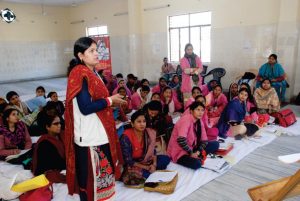 Good governance at all levels is important. To achieve this through community mobilisation and the empowerment process, the awareness of communities is being increased while also empowering them to hold service providers accountable and ensuring their rights. Tracking of pregnant and lactating women is undertaken to ensure they complete all ante-natal and post-natal check-ups and receive proper nutrition and adequate rest and care. Tracking helps understand who is dropping out of the regimen and why, thereby helping in tackling the problem. It also offers real-time data and helps in taking quick action.
Good governance at all levels is important. To achieve this through community mobilisation and the empowerment process, the awareness of communities is being increased while also empowering them to hold service providers accountable and ensuring their rights. Tracking of pregnant and lactating women is undertaken to ensure they complete all ante-natal and post-natal check-ups and receive proper nutrition and adequate rest and care. Tracking helps understand who is dropping out of the regimen and why, thereby helping in tackling the problem. It also offers real-time data and helps in taking quick action.
2. Interim Services
Support of interim services is offered in catering to the immediate needs of vulnerable communities. This includes organising health camps and providing emergency medical and nutritional support, demonstration of therapeutic foods from locally available resources to parents and children’s groups, and promotion of the kitchen garden at home, schools and ICDS centres.
3. Advocacy and Networking
Assessments of health and nutrition services institutions are done on the basis of adequacy of staff, infrastructural facilities and quality of services offered vis-à-vis the prescribed provisions and norms and the demands and representations given to various officials and stakeholders. Evidence-based advocacy is a regular process to requisition higher authorities, demanding action and accountability. Constructive collaboration with service providers and district/state level officials is also undertaken, besides networking and aligning with like-minded organisations, networks and entities, as required.
4. Capacity Building
The programming approach focuses on enabling the service provider and supporting/empowering them to take positive action for the community. It includes making them more sensitive to the needs and the situation of women and children from underprivileged backgrounds.
5. Model Building
A community-based management of malnourishment is done and pilot projects are undertaken on an experimental basis, creating a model for further replication in the State.
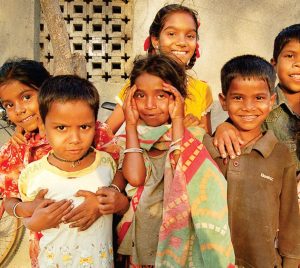 We continuously work with authorities to demand for basic health and nutrition services and Nutritional Rehabilitation Centres towards management of acute cases in our intervention areas. As part of system strengthening our programming, we also incorporate capacity building of service providers of primary health and nutrition services.
We continuously work with authorities to demand for basic health and nutrition services and Nutritional Rehabilitation Centres towards management of acute cases in our intervention areas. As part of system strengthening our programming, we also incorporate capacity building of service providers of primary health and nutrition services.
We do not see one particular issue in isolation but believe in holistic interventions. For instance, if a child is not fed properly, it leads to growth issues, and will later drop out of school. And the causes leading to malnutrition are many, including early marriage, not adequate gap being kept between each child born.
Ultimately, to control the menace of malnutrition and improve infant and mortality rates, the other practices promoted are sensitisation of mothers/families so that institutional deliveries increase. The importance of immunisation is also being propagated among backward sections. Finally, in the war against malnutrition, we believe each step counts and every life saved is equally important.
Soha Moitra is Regional Director, North, Child Rights and You (CRY)

